Tatty Devine – The British Duo of Fashion Accessory Design
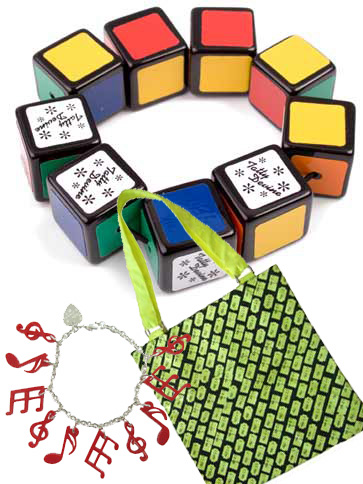 Tatty Devine was created in 1999. It is a unique and quirky accessory line. Rosie Wolfenden and Harriet Vine are the brains behind the successful jewelry designs. The company is based in Great Britain, and the two designers have no formal training as jewelers. Harriet and Rose met at Chelsea School of Art back in 1996. They had planned to become artists, but Harriet found some leather samples on the way home from the pub one night. She proceeded to make some leather cuffs. She and Rosie sold them at Portabello and Spitalfields markets—and Tatty Devine was born.
Tatty Devine was created in 1999. It is a unique and quirky accessory line. Rosie Wolfenden and Harriet Vine are the brains behind the successful jewelry designs. The company is based in Great Britain, and the two designers have no formal training as jewelers. Harriet and Rose met at Chelsea School of Art back in 1996. They had planned to become artists, but Harriet found some leather samples on the way home from the pub one night. She proceeded to make some leather cuffs. She and Rosie sold them at Portabello and Spitalfields markets—and Tatty Devine was born.
Harvey Nichols bought their accessories, then Browns, Focus, and Vogue Magazine took notice. Tatty Devine premiered their first official collection at London Fashion Week Spring, 2001. They have since shown their collection at Paris Fashion Week, and showcased in Berlin and New York, as well as having over 100 retail outlets worldwide.
I interviewed the British pair on their recent jaunt to LA and was thrilled to be given my own private showing of Tatty Devine’s collection.
“We express ourselves in everything we make. When we were in college, we did paintings—it’s all about the idea, and we were incubated in this conceptual cocoon. When we left college, we just hung out together, and all of our ideas and esthetics were really similar—we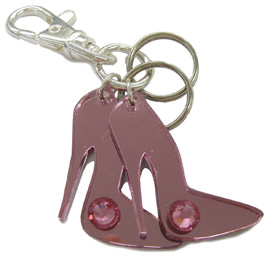 just started makingstuff.” —Harriet Vine and Rosie Wolfenden—
just started makingstuff.” —Harriet Vine and Rosie Wolfenden—
Harriet – It was just a series of fabulous events that just snowballed. You know, Rose was working at a vintage shop, and a woman from Vogue came in, and was just like, “Oh my gosh, I love that thing that you’re wearing. I really need it for my Millennium shot.” Then Rose had the audacity to say, “I made it myself. It’s from my company.” You know, so that was on Friday, and on Monday, we took to her … our …. It hadn’t existed on Friday!
Rosie – We made our collection on that weekend to take to Vogue. So we were just messing around having a really fun summer after college, visiting all the markets.
Harriet – We had no real desire to be fashion designers. We just wanted to be artists, to get studios, public views, and hang out with other artists. I guess if I had been a fashion student, I would have been really shy; but because I just didn’t really care, I admitted I made it myself.
Oh yeah, because you don’t have a reason to be afraid because you don’t really know what you’re doing anyway (laughs).
Harriet walked by a furniture store one night. They had thrown out all their leather sample booklets of every color, texture, and print—14 bins worth. Harriet dragged them all home;  they were perfect size twenty centimeters by twenty centimeters, which is the size of your wrist. We had ostrich skin and purple; we had snakeskin and blue; zebra skin and pink. Harriet just cut them up into wristbands.
they were perfect size twenty centimeters by twenty centimeters, which is the size of your wrist. We had ostrich skin and purple; we had snakeskin and blue; zebra skin and pink. Harriet just cut them up into wristbands.
Harriet – It was just before the whole eighties thing.
Rosie – So we took it to a market store, and everyone [loved them]. They sold for 5 and 10 pounds each.
They were just flying off the racks.
At first actually, people asked, “What is this? What do you do with it?” We told them they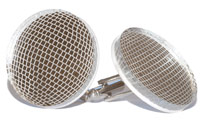 were wristbands. It took a little while, but within a month there were three other stands selling the same thing, but they could only afford to buy white leather.
were wristbands. It took a little while, but within a month there were three other stands selling the same thing, but they could only afford to buy white leather.
See that is a good thing. When someone is copying you, that is the highest possible compliment. That is when you say, “O.K., I am doing something right.” Tell me about your designs.
We’re kind of fascinated with history and fossils and dinosaurs. Apart from that, we really like the way the dinosaur necklace is made up of about 70 pieces. And each one is a bone from the dinosaur. They’re individually drilled, and we put our beads on individually. Sometimes we have to get them special order. Whenever I wear this [necklace], everyone is [in awe]. In London, people save up so they can buy it because they love it so much. We must have sold about 600 of these now.
It’s called the dinosaur necklace?
Yeah. That’s my favorite. Everything we care to make is in limited edition quantities. We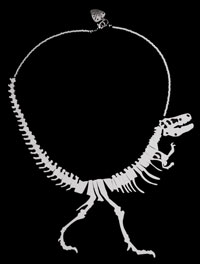 laser everything that gets mass made. We couldn’t make thousands of anything.
laser everything that gets mass made. We couldn’t make thousands of anything.
Do you have letters of authenticity with your jewelry?
Well, that’s a really good idea because they do that in Singapore and Japan.
I’m sure they’ve got collector’s value. Down the line it could be worth something.
In Britain we don’t have to do it because everyone knows. Until recently they’d come to our shop and they’d watch the jewelry getting made. But I think letters of authenticity would be a very nice touch.
What are the materials you used to make these?
[In addition to other things], we used acrylic because it gives us the freedom to be very literal in our designs. We use [a variety of] wood, leather, solid silver, and Swarzsky Crystals. Then we create the drawings in the computer, which later goes into a [special] machine, which cuts out our drawings. It’s really nice. It’s like cookie cutters.
But it’s taken awhile to come up with such a smooth process, right? A lot of trial and error?
At first it was leather cuffs and then we moved on to hand cut leather shapes, and then we’d sew crystals on things. It’s like writing a Christmas list.
You’re actually setting a trend. And you guys really know how to market yourself. Do you think that has something to do with your success?
Up until a year ago, we were answering the phones. We were writing the press releases, trying to organize everything. My God, we nearly went mad. We’re finding liberation and now we’ve got 10 employees.
Tell me your highest high as jewelry designers.
When we got into Fashion Week, it was big. Every day something new comes along. I like that initial time of going to Vogue Magazine. That was quite amazing. It seems so crazy. We were like just two Indie kids—we were only 21..
What did your parents think about all this?
Rosie – My mum asked me what was I going to do when I finish college. [My parents] were a bit scared, because my parents were both self-employed and Harriet’s parents were always doing projects. Both of our parents are entrepreneurs. It never occurred to me to have a desk job. Not that I’d come into any money or anything, but I always thought I’d find my way.
Have you ever had any disappointments?
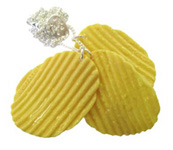 Not really. The biggest downer we had was when we participated in the Designers and Agents Show—it’s a trade show. We did it and it was great. And then we applied to do it again and we weren‘t accepted, which is annoying because we wanted to come over here. It wasn’t quite right. Because there’s nothing else quite like it. It’s really hard.
Not really. The biggest downer we had was when we participated in the Designers and Agents Show—it’s a trade show. We did it and it was great. And then we applied to do it again and we weren‘t accepted, which is annoying because we wanted to come over here. It wasn’t quite right. Because there’s nothing else quite like it. It’s really hard.
What advice would you give an aspiring entrepreneur?
You have to have a belief in yourself and have some interesting stuff. It’s not good enough just wanting to make jewelry. You’ve got to be interesting and have a lot of cool stuff, and have original ideas. Because it’s so dull seeing something that’s copied. Seeing something original really does just make my heart skip a beat. It’s lovely. And I think that’s what’s really important with our designs—they were just so fresh. You’ve really got to have faith in yourself, have no fear, and be prepared not to have any money for a while. We started with absolutely nothing. We started at zero, and months later we [earned] 200 pounds. And then we bought some more leather and then we sold it … and then we had 400 pounds. We never had a proper job, so we didn’t know what money was.
You didn’t know what to charge?
You really must be prepared for the fact that it takes a long time before you can really have a life. You just make jewelry all the time. You have to be prepared to work really hard; but to enjoy working really hard, have passion. And just like having initiative, I guess.
You guys are hard wired for business. I think it’s just in you. You’re artists, but you’re hardwired to be entrepreneurs, leaders.
I think entrepreneurship is a really creative thing. There’s business and then there’s being an entrepreneur. Entrepreneurship is the creative side of business. Because business really is creative. You can manipulate and point it to any direction you want.
To learn more about Tatty Devine and their collections, visitwww.tattydevine.com.
Interviewed by Kaylene Peoples